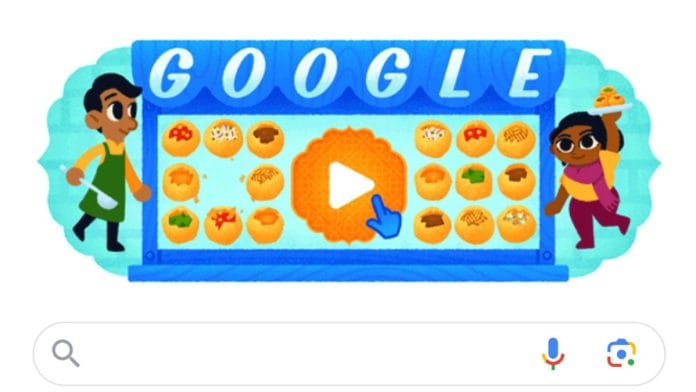New Delhi: Reimagining pani puri in a ‘Candy Crush Saga’-like avatar, Google launched its new doodle game, India’s first F-oodle (Google Doodle honouring Indian food) on Wednesday.
The interactive doodle game commemorates Indori Zayka’s World Record of curating 51 flavours of panipuri, with Dainik Bhaskar and the guidance of Masterchef Neha Shah on this day in 2015. Indor Zayka is an Indore-based restaurant run by Rakesh Dawani.
‘Pani Puri Day’ on popular demand
Google described pani puri as a “popular South Asian street food made of a crispy shell stuffed with potatoes, chickpeas, spices, or chillies and flavoured waters.” The buzz about the doodle on the internet has led many to designate 12 July as the official ‘Pani Puri Day.’
The game entails helping a street vendor complete orders by matching the customer quantity and flavour preferences with the right fuchka flavors from the matrix.
The doodle is live in most parts of North America, Australia, Pakistan, Germany, the United Kingdom, Nepal, and Brazil.
Across the nation, the snack is prepared differently — sometimes, it is filled with a chickpea and potato mixture, while other times it is dipped in tangy tamarind water. This bullet snack is referred to as puchka, gol gappa, fuchka, fulki, pataashi, pakodi, gupchup, and padake and is mixed and matched with other chaats across India, such as dahi chaat and sevpuri.
Sparking a trend on Twitter, Google India asked users to choose their teams depending on the different names of this omnipresent snack.
What you call it in your region is the team you’re scoring for ? https://t.co/SjK83mC8NV
? tap on the #GoogleDoodle and lesssgoooo
Are you:
⚪#TeamPaniPuri ⚫#TeamGolGappe ?#TeamFuchka ?#TeamPuchka ?#TeamFulki ?#TeamPataashi ?#TeamPakodi ?#TeamGupchup ?#TeamPadake https://t.co/GQHZD1PLP7
— Google India (@GoogleIndia) July 12, 2023
Disputed origins of Pani Patashe
While tracing back the origins of any delicacy is a disputed matter, there is a certain unanimity over the internet about the Indian invention of pani puri. The mythological version, as also documented in Amar Chitra Katha, entails Draupadi inventing phulki with the minimum resources Kunti, her mother-in-law, had handed her down during the Pandavas’ exile in the Mahabharata.
Written accounts of the dish can be found in the travelogues of Faxian, a Chinese Buddhist pilgrim, and Greek historian Megasthenes. The accounts discuss the popular consumption of the snack in Magadha, one of the 16 mahajanapadas, during 600 BCE.
Dr Kurush Dalal, a cultural anthropologist, told the BBC that chaat, a likely predecessor of modern pani puri, was invented in modern-day Uttar Pradesh. This alternative history of pani puri goes back to around the time of Emperor Shah Jahan’s rule in the late 17th century.
According to Dalal, royal doctors advised common folks to consume more fried and spicy snacks alongside yoghurt to balance the alkalinity of the Yamuna River. This was because Shah built a new capital, Old Delhi, on the banks of Yamuna. The batashe served as “bite-sized containers of chaat masala” and then spread to the rest of the nation through migrant workers.
Some other interesting facts
The word ‘pani puri‘ was added to the Oxford English Dictionary in March 2005. Additionally, Japanese Prime Minister Fumio Kishida savoured the snack with PM Narendra Modi during his official visit in April earlier this year.
Google has celebrated other popular delicacies in the past as well, including pizza, tempeh, pho, and pad thai.
Also read: “North Indians sell panipuri in Tamil Nadu, Guv is also like them”: DMK leader Bharathi






